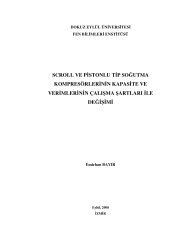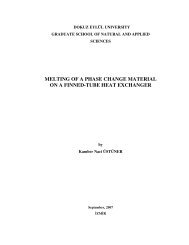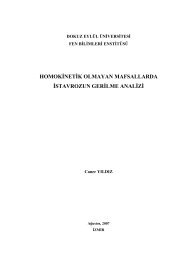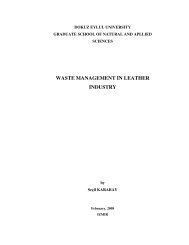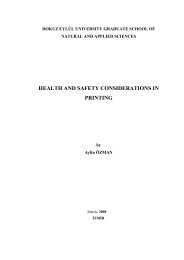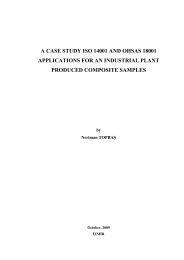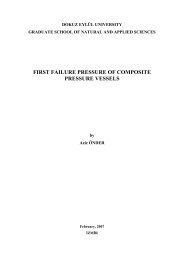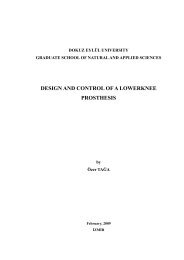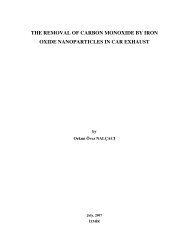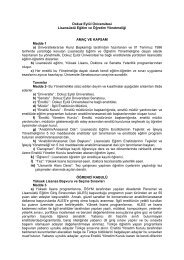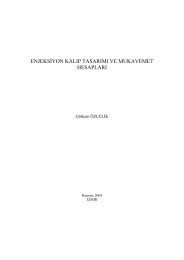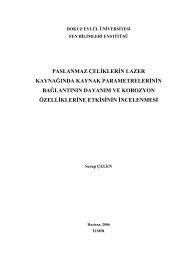DETERMINATION OF THIN FILM'S MECHANICAL PROPERTIES
DETERMINATION OF THIN FILM'S MECHANICAL PROPERTIES
DETERMINATION OF THIN FILM'S MECHANICAL PROPERTIES
Create successful ePaper yourself
Turn your PDF publications into a flip-book with our unique Google optimized e-Paper software.
<strong>DETERMINATION</strong> <strong>OF</strong> <strong>THIN</strong> FILM’S <strong>MECHANICAL</strong><strong>PROPERTIES</strong>byOsman ÇULHADecember, 2006İZMİR
<strong>DETERMINATION</strong> <strong>OF</strong> <strong>THIN</strong> FILM’S <strong>MECHANICAL</strong> <strong>PROPERTIES</strong>ABSTRACTThe surface of industrial component may require treatment to enhance surfacecharacteristic. Surface treatments that cause microstructure changes in the bulk materialinclude heating and cooling/quenching through induction, flame, laser and electron beamtechniques, or mechanical treatments.Boriding is one of the thermo chemical surface treatment processes which is extensivelyused for ferrous and nonferrous materials. In this study, characterization and mechanicalproperties of FeB and Fe 2 B phases, which were formed on surface of SAE 1020 and SAE1040 quality steel by boriding technique, were investigated.The aim of this study was to obtain micro structural characteristics and investigate themechanical properties such as hardness, young’s modulus and fracture toughness of theboride layer. The produced double layer (FeB and Fe 2 B) was extensively analyzed withrespect to X-ray diffraction (XRD), scanning electron microscopy (SEM) including energydispersive spectroscopy (EDS), microhardness and surface roughness. Mechanical propertiesof layers was examined by Shimadzu Dynamic Ultra-micro Hardness test machine forestimating young’s modulus due to load-unload sensing analysis, in addition to mechanicalinvestigation hardness-depth curves of the layer was obtained. Fracture toughness propertiesof surface layer FeB was calculated by Vickers Fracture Toughness method with measuringcrack length after loading stage is finished.Finite element modeling was performed todetermine the yield stress and stress analysis of borided substrates.Keywords: Boriding, micro-indentation, Fracture toughness, Finite Element Method.
İNCE FİLMLERİN MEKANİK ÖZELLİKLERİNİN BELİRLENMESİÖZEndüstride kullanım alanına sahip birçok malzeme yüzey özelliklerinin iyileştirilmesineihtiyaç duymaktadır. Yüzey iyileştirme işlemleri, yüzeyin mikro yapısal özelliklerinitermokimyasal yöntemle (ısıtma ve soğutma işlemleriyle) değiştirmeye yöneliktir. Başlıcaısıtma işlemleri alevle, lazerle ve elektron beam tekniklerini içermekte, soğutma ise su verme,havada ve yağda soğutma işlemlerini kapsamaktadır.Borlama işlemi, demir ve demir dışı metallere uygulanabilen termokimyasal yüzeyişlemlerindendir. Bu çalışmada, SAE 1020 ve SAE 1040 kalite çelikler borlama işlemine tabitutularak oluşturulan FeB ve Fe 2 B fazlarının karakterizasyonu ve mekanik özelliklerininbelirlenmesi hedeflenmiştir.Bu çalışmanın amacı, borür tabakalarının mikro yapısal özelliklerinin yanı sıra sertlik,elastisite modülü ve kırılma tokluğu gibi mekanik özelliklerinin belirlenmesidir. Üretilen FeBve Fe 2 B içeren çiftli tabaka, taramalı elektron mikroskobu ve X ışınları difraksiyon cihazı,mikro sertlik ve yüzey pürüzlülüğü cihazları ile detaylı olarak incelenmiştir. Tabakalarınmekanik özelliklerinden olan elastisite modülü ve sertlik-derinlik değişimi ShimadzuDynamic Ultra-mikro Hardness test cihazı kullanılarak belirlenmiştir. FeB tabakasına aitkırılma tokluğu değeri ise Vickers kırılma tokluğu deney prosedürü uygulanarak eldeedilmiştir. Sonlu elemanlar metodu ise FeB tabakasına ait akma gerilmesi tayini ve gerilmeanalizi yapmak için kullanılmıştır.Anahtar Kelimeler: Borlama, Mikro Indentation, Kırılma Tokluğu, Sonlu Elemanlar metodu1. IntroductionAlthough well known for approximately 100 years, classical hardness test has gained newpopularity during the last decades.The advantage of the indentation test, in comparison with a uniaxial tensile test, is ofcourse the relative simplicity of the experimental setup. On the other hand, an obviousdrawback is the very complicated mechanical problem arising owing to inelastic and/or
inhomogeneous deformation in the indented materials. Therefore, until recently theinterpretation of indentation tests have relied heavily on semi-empirical formulae. The workby Tabor is perhaps the best example of this, with no or little theoretical foundation. With theadvent of modern computers and advanced numerical methods, however, the understanding ofthe mechanics involved during ball indentation (Hill et al., 1989; Kral et al., 1993; Larsson,1994), cone indentation (Laursen and Simo, 1992) and Vickers Indentation (Giannakopoulosand Suresh, 1994), has increased rapidly in recent years.These new interests in the mechanical behavior of indentation testing are to a large extent aresult of the increased use of new materials. These materials are notoriously difficult tocharacterize through uniaxial or other standard tests, which in many cases make indentationtesting the only possible alternative for determining their mechanical properties.The qualities of small size and non-destructive test capability make the indentationtechnique superior to the tension test. For very small volumes of material, the uniaxial test isinapplicable. Furthermore, the structural materials may not be removed to do the tension testin most cases, for instance, the materials used in the electronic solders or engineering welds.Indentation technique can evaluate the material properties while keeping the structuralintegrity.Sharp indentation tests also serve to initiate and control fracture in brittle materials. Mucheffort has been devoted to fracture toughness determination. Other applications that refer to,or use indirectly, the Vickers hardness include abrasive wear problem, armor plating,machining, etc. Most tests are of static type; however, several dynamic tests are alsoperformed.Another main application area of indentation technique lies in the thin film – substratesystems research. Thin film coatings have been widely used in various industries in recentdecades. The coated products have become crucial to machine parts performance anddurability, multiplying the life span of some parts by 10 to 20 times.For instance, the mechanical properties of FeB and Fe 2 B layers are important for industrialapplication. Pack boriding process was applied to SAE 1020 and SAE 1040 quality steel forachieving advantages such as:
• Hardness of the boride layer can be retained at higher temperatures than, for example,that of nitrided cases.• A wide variety of steels, including through-hardenable steels, are compatible with theprocesses (Mater. Eng, 1970)• Boriding, which can considerably enhance the corrosion-erosion resistance of ferrousmaterials in nonoxidizing dilute acids as indicated in chapter two Fig. 2.4 and alkalimedia, is increasingly used to this advantage in many industrial applications (W.J.G.Fichtl).• Borided surfaces have moderate oxidation resistance (up to 850) and are quite resistantto attack by molten metals.• Borided parts have an increased fatigue life and service performance under oxidizingand corrosive and corrosive environment.After pack boriding process, multilayer diffusion phases (FeB and Fe 2 B) formed onsteel substrate. The structural compositions of layers consist of boron rich phase (FeB)and iron rich phase (Fe 2 B), respectively. FeB formation begins from surface, Fe 2 B phaseforms in deeper region because of decreasing boron concentration form surface to insideof substrate. Upper part of multilayer consists of FeB phase which is more brittle thanlower layer (Fe 2 B).Mechanical properties (Young’s modulus, Hardness, Yield strength) of FeB layer aredifficult to characterize through uniaxial or other standard tests. So, micro indentation methodbecame useful for determination of mechanical properties of layers.2. Experimental StudiesX-ray diffraction (XRD) patterns of FeB layers were determined by means of multipurpose Rigaku D/Max-2200/PC Model diffractometer with a Cu K α radiation by using multipurpose thin film attachment. Measurements were performed by applying 40 kV voltages and36 mA current. The surface morphologies of FeB and Fe 2 B layers were examined by aScanning Electron Microscope (JEOL-JSM 6060 SEM) with an Energy Dispersive X-rayspectroscopy (IXRF System EDS) system attachment. Accelerating voltage of 20 kV was
used for the SEM imaging and SEM/EDS analyses. SJ-301 Mitutoyo surface roughness testerwas used for determination of FeB layers roughness. Test measurement results give; Ravalues of surface which means the differences between maximum and minimum asperitiesheight versus measurement distance. Mechanical and elastic properties (hardness, youngmodulus, yield stress, etc.) of FeB layers were obtained from load-indentation curves by usingultra-micro hardness tester.Finite element simulations are performed for the problem of Vickers indenter brought intocontact against an infinite half space. Both the indenter and half space are modeled as axialsymmetry geometry. While the isotropic hardening has been regarded as an accurate model infinite element modeling of indentation, this assumption is merely a simplification of the truemechanical response of the material as the shape of the yield locus in most metals variesduring plastic flow. M. Mata et al. stated that ‘the hypothesis of isotropic hardening isconsidered to provide accurate results in the analysis of loading histories where no reversedplastic deformation occurs well beyond the yield surface. The response is taken to be rateindependent, so in the quasi-static calculations presented here no rate effects are represented.The influence of large deformation is included in the analysis by using geometry nonlinearityactivated in ABAQUS. The Von Misses yield criterion is taken for the computation.3. Results and Discussion3.1 FeB and Fe 2 B Layer CharacterizationThe XRD pattern of the borided layers, which was formed on SAE 1020 and 1040 qualitysteel at 900 o C for 2, 4 and 6h, are given in figure 3.1 and figure 3.2, respectively. Accordingto this pattern, layer includes only FeB phase with (111), (210), (101) and (111).
140120100SAE 1020 Quality Steel Borided at 900 C2h borided4h borided6h boridedIntensity (%)80604020039 44 49 54 59 64 692 ThetaFigure 3.1 Phase analysis of 1020 steel borided at 900 o C for 2h, 4h, and 6h140120SAE 1040 Quality Steel Borided at 900 C2h borided4h borided6h borided100Intensity (%)80604020039 44 49 54 59 64 692 ThetaFigure 3.2 Phase analysis of 1040 steel borided at 900 o C for 2h, 4h and 6h.
Both XRD examinations of borided layers show that only FeB phase exists on the surface.But if used SEM, cross-sectional investigation of layers demonstrate that two diffusion layers(FeB and Fe 2 B) in saw-tooth shapes.SEM cross-sectional investigations show that double phase layer from surface to inside ofsubstrate. SEM cross-sectional photograph of SAE 1020 and SAE 1040 quality steels, whichwas borided at 900 o C for 2, 4 and 6h, are shown in Figure 3.3. and Figure 3.4., respectively.The structural compositions of layers consist of boron rich phase (FeB) and iron rich phase(Fe 2 B), respectively. FeB formation begins from surface, Fe 2 B phase forms in deeper regionbecause of decreasing boron concentration form surface to inside of substrate. According tothe SEM photograph, saw tooth microstructural images show both FeB and Fe 2 B phase.a) b)c)Figure 3.3 Borided layer thickness of 1020 steel for different process time SAE 1020 steela) 2 h borided, b) 4 h borided, c) 6 h borided
During boriding, the diffusion and subsequent absorption of boron atoms into metalliclattice of component surface form interstitial boron compounds. The resulting layer mayconsist of either a single phase boride or polyphase boride layer. Saw-tooth shape diffusionmicrostructures of borided SAE 1020 and SAE 1040 are illustrated in Figure 3.3. and Figure4.4., respectively. From SEM-BEC photographs can be seen that films consist of two differentdiffusion layers. According to the micro structure graphs; dark region symbolizes FeBdiffusion layer while bright areas indicate Fe 2 B diffusion layer. Increase in time from 2h to 6h, FeB and Fe 2 B layers thicknesses increase; as expected.a) b)c)Figure 3.4 Borided layer thickness of 1040 steel for different process time SAE 1020 steela) 2 h borided, b) 4 h borided, c) 6 h borided
The formation of a single Fe 2 B phase (with saw tooth morphology due to preferreddiffusion direction) is more desirable than a double-phase layer (FeB and Fe 2 B). Because ofFeB is more brittle than the iron sub boride Fe 2 B layer, the boron rich FeB phase isconsidered undesirable. Also, because FeB and Fe 2 B formed under tensile and compressiveresidual stress, respectively, crack formation is often observed at or in the neighborhood ofthe FeB / Fe 2 B interface of double-phase layer as seen in Figure 3.3 and Figure 3.4. forborided SAE 1020 and SAE 1040 quality steels, respectively. These cracks may lead toflaking and spalling when a mechanical strain is applied or even separation when acomponent is undergoing a thermal and/or mechanical shock.Average thickness measurement of FeB and Fe 2 B layer on SAE 1020 and SAE 1040 listedin Table 3.1. Because boriding process is controlled by diffusion parameter such as time andtemperature, formed layer thicknesses change with these parameters.Table 3.1 Average thickness measurement of different hour borided steelMaterialTypeSAE 1020SAE 1040BoridingTime(hour)FeB LayerThickness (µm)Fe 2 B LayerThickness (µm)Total Thickness(µm)2 23.6 27.3 50.94 27.1 70.1 97.26 42.5 90.8 133.32 29.8 56.8 86.64 37.4 63.6 1016 49.8 69.7 119.53.2 Surface Roughness MeasurementSurface roughness value of samples is important parameter for nano-indentation test withDynamic Ultra Micro Hardness Tester. After diffusion controlled boriding process, materialsurface roughness can be high for micro-indentation test. So, surface polishing process isapplied for decreasing roughness of FeB layers. Because of micro indentation test result’ssensitivity and homogeneity, polishing process must be applied whole surface to minimize Ravalue of samples.
Table 3.2 Surface roughness measurements of samplesSamples SAE 1020/Fe 2 B/FeB SAE 1040/Fe 2 B/FeBProcess Time (hour) 2 4 6 2 4 6Before Polishing Ra(micrometer)After Polishing Ra(micrometer)0.90 0.95 1 0.89 0.95 1.20.09 0.08 0.010 0.05 0.07 0.093.3 Ultra Micro Hardness Examination of SamplesThe mechanical properties such as hardness, Young’s modulus, fracture toughness,ductility, etc are important parameters for industrial application. Shimadzu Dynamic UltraMicro Hardness Testing machine is used for determination hardness variation and youngmodulus of FeB layers. The three key parameters such as peak load (P max ), the contact area(A c ) and the initial unloading contact stiffness (S) can be determined by load unload test modefor different loading value.Hardness (HDV)450004000035000300002500020000150001020-2-6401020-4-6401020-6-640Hardness (HDV)200001800016000140001200010000800060001020-2-3201020-4-3201020-6-3201000040005000200000 0,2 0,4 0,6 0,8 1 1,2 1,4 1,6 1,8Depth "h" (micrometer)00 0,2 0,4 0,6 0,8 1 1,2Depth "h" (micrometer)a) b)Hardness (HDV)30000250002000015000100001020-2-1601020-4-1601020-6-160Hardness (HDV)3500030000250002000015000100001020-2-801020-4-801020-6-805000500000 0,1 0,2 0,3 0,4 0,5 0,6 0,7 0,8 0,9Depth "h" (micrometer)00 0,1 0,2 0,3 0,4 0,5Depth "h" (micrometer)c) d)Figure 3.5 Hardness - penetration depth curve of 2h, 4h and 6h borided SAE 1020 qualitysteel under a) 640 mN, b) 320 mN, c) 160 mN and d) 80 mN, peak loads.
Different load range such as 640 mN, 320 mN, 160 mN and 80 mN is applied fordetermination of hardness and Young’s modulus. Hardness results of 2h, 4h, and 6h boridedSAE 1020 quality steel at 640 mN, 320 mN, 160 mN and 80 mN peak loads, are shown inFigure 3.5.The figures were constructed experimentally using the data taken from the loading part ofdepth setting DHV measurements at 640 mN, 320 mN, 160 mN and 80 mN applied peak loadfor each sample in Figure 3.5 and Figure 3.6 for borided SAE 1020 and SAE 1040 qualitysteel, respectively. Because diffusion controlled process used to form FeB layer, structureand composition can be changed from surface into samples. As follows, surface of samplesconsist of too much boron concentration in respect to inside of samples. So, composition andstructure change depending on diffusion distance from surface to inside of specimen asexplained chapter 3. In addition to hardness behaviour of FeB layer as shown figure 3.5 andfigure 3.6, it is seen that HV numbers decrease with increasing applied peak load from surfaceto inside of layer. Since hardness is accepted as an inherent material property, it should notvary with indentation load and size. However, investigations have confirmed that HV numberof materials were indentation size dependent especially at lower peak loads. Increase inhardness with decreasing applied peak load cause from differences in indentation depth,therefore this effect is called indentation size effect. Figure 3.5 and figure 3.6 exhibit this kindof behaviour.1800016000140001040-2-6401040-4-6401040-6-6404500040000350001040-2-3201040-4-3201040-6-320Hardness (HDV)1200010000800060004000200000 0,2 0,4 0,6 0,8 1 1,2 1,4 1,6 1,8 2Depth "h" (micrometer)Hardness (HDV)3000025000200001500010000500000 0,2 0,4 0,6 0,8 1 1,2Depth "h" (micrometer)a) b)
5000045000400001040-2-1601040-4-1601040-6-1602500002250002000001040-2-801040-4-801040-6-80Hardness (HDV)350003000025000200001500010000500000 0,1 0,2 0,3 0,4 0,5 0,6 0,7 0,8Depth "h" (micrometer)Hardness (HDV)17500015000012500010000075000500002500000 0,1 0,2 0,3 0,4 0,5Depth "h" (micrometer)c) d)Figure 3.6 Hardness - penetration depth curves of 2h, 4h and 6h borided SAE 1040 qualitysteel with a) 640 mN, b) 320 mN, c) 160 mN and d) 80 mN peak loads.With the ever increasing research and application interests in surface coatings, micro ornano indentation experiments have been extensively used to determine the mechanicalproperties of materials. Hardness and Young’s modulus are the two frequently studied ones.FeB layers hardness examinations were made by different applied peak loads. The loadunloadmode (load–displacement) curves shown in Figs. 3.7–3.8 (SAE 1020 and 1040 qualitysteel with 2h, 4h and 6h boriding process time, respectively) represent the 640mN, 320 mN,160mN and 80mN applied load as a function of the displacement (elastic and plastic) of theindenter with respect to the initial position of the surface and Table 3.3 shows the hardness,Young’s modulus, residual depth and maximum depth value of samples under 640mN, 320mN, 160mN and 80mN applied peak loads.Force (mN)7003506506003005505002504504002003501503002501002001501020-2-3201001020-2-640501020-4-320501020-4-6401020-6-3201020-6-640 000 0,1 0,2 0,3 0,4 0,5 0,6 0,7 0,8 0,9 1 1,1 1,20 0,2 0,4 0,6 0,8 1 1,2 1,4 1,6 1,8 2 2,2 2,4Depth "h" (micrometer)Depth "h" (micrometer)Force (mN)a) b)
Force (mN)1801601401201008060401020-2 160201020-4 1601020-6 16000 0,1 0,2 0,3 0,4 0,5 0,6 0,7 0,8 0,9Depth "h" (micrometer)Force (mN)90807060504030201020-2-80101020-4-801020-6-8000 0,05 0,1 0,15 0,2 0,25 0,3 0,35 0,4 0,45 0,5 0,55Depth "h" (micrometer)c) d)Figure 3.7 A series of load-displacement plots at different peak loads of SAE 1020/FeBlayers with 2h, 4h and 6h process time, a) 640mN, b) 320 mN, c) 160 mN, d) 80 mNA schematic representation of indentation load (P) versus displacement (h) data obtainedduring one full cycle of loading and unloading is presented in Figure 3.7-3.8. The importantquantities are the peak load (P max ), the maximum depth (h max ), the final or residual depth afterunloading (hr), contact depth (h c ) and the slope of the upper portion of the unloading curve(S=dP/dh). The parameter S has the dimensions of force per unit distance and is known as theelastic contact stiffness, or more simply, the contact stiffness.In order to determine the elastic modulus, maximum applied load should be sufficient toproduce a permanent deformation on the coating surface. So that the values of elasticmodulus, determined from indentations, do not depend on the value of h and, therefore, on thevalue of the maximum load, the indentation depth should not exceed 10-25 % of the coatingthickness, otherwise the results will be affected by the properties of the substrate. In thisstudy, diffusion controlled FeB layers thickness measurement results show that maximumthickness is 42.5 µm and 49.8 µm for SAE 1020 and SAE 1040 quality steel, respectively andmaximum indentation depth are 2.126 and 1.646 for SAE 1020 and SAE 1040 quality steel,respectively as shown in Table 3.3.
Force (mN)7006506005505004504003503002502001501040-2-6401001040-4-640501040-6-64000 0,2 0,4 0,6 0,8 1 1,2 1,4 1,6 1,8h (micrometer)Force (mN)3503002502001501001040-2-320501040-4-3201040-6-32000 0,1 0,2 0,3 0,4 0,5 0,6 0,7 0,8 0,9 1 1,1 1,2Depth "h" (micrometer)a) b)Force (mN)1801601401201008060401040-2 160201040-4 1601040-6 16000 0,1 0,2 0,3 0,4 0,5 0,6 0,7 0,8 0,9Depth "h" (micrometer)Force (mN)90807060504030201001040-2-801040-4-801040-6-800 0,05 0,1 0,15 0,2 0,25 0,3 0,35 0,4Depth (h) micrometerc) d)Figure 3.8 A series of load-displacement plots at different peak loads of SAE 1040/FeBlayers with 2h, 4h and 6h process time, a) 640mN, b) 320 mN, c) 160 mN, d) 80 mNS=dPdh=2Eπ*A c21 1−ν1−ν0= +E ErE o2E r is called reduced modulus or combined modulus, S=dP/dh s is the experimentallymeasured stiffness of the upper portion of the unloading data, which is the slope of the curvefitted straight line of the initial part of unloading, A is the projected contact area of theindenter at maximum loading condition, E and ν are Young’s modulus and Poisson’s ratio forthe specimen, and E o and ν o are the same parameter for the indenter. Using the experimentallydetermined S and h c , the reduced elastic modulus by micro indentation was calculated and the
esults are shown in Fig. 3.9 a) and Fig. 3.9 b) for borided SAE 1020/FeB and SAE 1040/FeBquality steels, respectively. It is clearly seen from the figures that the extracted reduced elasticmodulus also exhibits a strong peak load dependency as shown in Table 5.3. According to theresult, Young’s modulus values increase with decreasing applied peak loads in peak load.Table 3.3 D.U.H analysis of borided SAE 1020 and SAE 1040 quality steelsMaterial Type1020–2h1020–4h1020–6h1040–2h1040–4h1040–6hLoad(mN)MaximumDepth (µm)ResidualDepth (µm)Hardness(DHV)Young’sModulus(GPa)640 2.126 1.383 775 125320 1.102 0.641 1001 240160 0.781 0.499 1033 27680 0.280 0.038 1621 432640 1.637 1.099 892 271320 0.899 0.544 1060 342160 0.560 0.301 1310 35280 0.453 0.305 1552 566640 1.577 1.088 1081 241320 0.869 0.554 1277 396160 0.795 0.506 1381 39780 0.501 0.381 1788 568640 1.646 1.040 1015 273320 1.094 0.669 1045 285160 0.751 0.323 1367 34580 0.369 0.127 1961 496640 1.530 1.061 1102 366320 0.908 0.527 1190 391160 0.562 0.237 1736 49780 0.269 0.065 2280 596640 1.677 1.125 1120 285320 0.878 0.504 1210 400160 0.709 0.423 1486 55180 0.211 0.050 2244 624
6005001020-21020-41020-67006001040-21040-41040-6400500E (GPa)300200E (GPa)40030020010010000 100 200 300 400 500 600 700Load (mN)00 100 200 300 400 500 600 700Load (mN)a) b)Figure 3.9 The elastic modulus extracted from the analysis of the load-displacement curves as afunction of the peak loads for; a) SAE 1020/FeB, b) SAE 1040/FeB3.4 Fracture Toughness MeasurementThe fracture toughness of a material is of critical importance for use in mechanicalapplications. The use of the Vickers indentation method to asses fracture toughness of brittlematerials, particularly glasses and ceramics has been well developed. This technique can beused on small samples. The specimen preparation is relatively simple requiring only a flat andpolished surface (Ugur Sen et al, 2005). The Vickers diamond indenter is a standard item usedon a dedicated hardness tester or on a universal testing machine. In many instances the cracklengths can be measured optically without difficulty. It is also quick and cost-effective (A.H.Üçisik, C. Bindal, 1997). Fracture toughness was measured with a Vickers indenter under aload of 10 N. Crack lengths were immediately measured under SEM.For 1020–2 ;F 98,0712H = == 0,0138x10N2 22a2xm−6( 59,49x10)2KIC⎛ E= 0,016x⎜⎝ H⎟⎠⎞12xF3( C ) 2b3⎛ 590x10⎜= 0,016x10⎜⎜ 0,0138x10⎝= 0,9188MPa m−612⎞⎟⎟⎟⎠12x98,073−6( 107,63x10) 2
For 1020–4;F 98,0712H = == 0,0103x10N2 22a2xm−6( 68,855x10)2KIC⎛ E= 0,016x⎜⎝ H⎟⎠⎞12xF3( C ) 2b3⎛ 590x10⎜= 0,016x10⎜⎜ 0,0103x10⎝−612⎞⎟⎟⎟⎠12x98,073−6( 102,6x10) 2= 1,1427MPamFor 1020–6;F 98,0712H = == 0,0139x10N2 22a2xm−6( 59,205x10)2KIC⎛ E= 0,016x⎜⎝ H⎟⎠⎞12xF3( C ) 2b3⎛ 590x10⎜= 0,016x10⎜⎜ 0,0139x10⎝−612⎞⎟⎟⎟⎠12x98,073−6( 93,73x10) 2= 1,1265MPamFor 1040–2;F 98,0712H = == 0,037x10N2 22a2xm−6( 115x10)2KIC⎛ E= 0,016x⎜⎝ H⎟⎠⎞12xF3( C ) 2b3⎛ 590x10⎜= 0,016x10⎜⎜ 0,037x10⎝−612⎞⎟⎟⎟⎠12x98,073−6( 134,55x10) 2= 0,4014MPam
For 1040-4;F 98,0712H = == 0,0074x10N2 22a2xm−6( 81,1 x10)2KIC⎛ E= 0,016x⎜⎝ H⎟⎠⎞12xF3( C ) 2b3⎛ 590x10⎜= 0,016x10⎜⎜ 0,0074x10⎝−612⎞⎟⎟⎟⎠12x98,073−6( 88,29x10) 2= 1,6888MPamFor 1040-6;F 98,0712H = == 0,0122x10N2 22a2xm−6( 63,38x10)2KIC⎛ E= 0,016x⎜⎝ H⎟⎠⎞12xF3( C ) 2b3⎛ 590x10⎜= 0,016x10⎜⎜ 0,0122x10⎝−612⎞⎟⎟⎟⎠12x98,073−6( 83,67x10) 2= 1,4257MPam3.5 FEM ModelIn order to improve the calculation accuracy in the continuous FEM simulation of thenanoindentation, an axisymmetric FEM model of the semi-infinite layered half space wasbuilt (Swanson Analysis system, 1995). To fulfill this target it was necessary to replace theVickers pyramid through an equivalent cone. This replacement increases the calculationaccuracy, since it enables the description of a three-dimensional problem through theapplication of a plane axisymmetric model. The lack of edge regions of the pyramid indentornegligibly affects the penetration procedure, because these regions are limited in comparisonto the whole contact indentor-specimen area.
FEM was performed with the commercial software package ABAQUS 6.5-1. The modelwas constructed with axial symmetry geometry as illustrated Figure 3.10. The indenter had aconical tip with semi-vertical angle of 70.3, which gives the same area-to-depth function asBerkovich and Vickers indenters. At the very tip of the indenter, a spherical rounding with aradius of 0.5 mm was constructed because of the fact that no real indenter can be ideallysharp. The indenter had a cylindrical body which was large enough to uniformly transfer theload from the top surface to the contact area. The material of the indenter was taken asdiamond and assumed to be elastic with Young’s modulus of E s = 1140 GPa and Poisson’sratio=0.04 (C.A. Brookes, 1979). Figure 3.10 shows the schematic of the finite elementmodel used in this work.The indenter was meshed by approximately 1500 four-node and 18500 four-node and eightnodes for specimen. Elements were finest and in the central contact area and became coarseroutwards and CAX4R and Quad-dominated element types were used. The interaction betweenthe diamond indenter and specimen was modeled by without contact element with no friction.Figure 3.10 Schematic of the finite element model used in this work
In this study, the FeB layers were modeled as elastic, perfect-plastic materials (Young’smodulus E= 595 GPa, Poisson’s ratio, ν= 0.2). Yield strength was assumed to be between 5and 7 GPa to determine the same penetration depth with experimental results. The substratewas chosen to be commercial steel and was modeled as elastic material with E= 205 GPa andν=0.3 and yield strength= 280 MPa, ultimate strength= 600 and work hardening exponent=0.2 (J.L.He, S. Veprek, 2003).Figure 3.10 and figure 3.11 show mesh design of the entire model and magnified view ofmesh design under Vickers indenter (with 70.3 o equivalent angle). Numerical analysis stepsinclude; loading, holding and unloading parts. Figure 3.12 a) and b) and Figure 3.13 showloading and unloading step modules with Von Misses stress distribution at contact region ofindenter and layer, respectively.Figure 3.10 Mesh design of in the entire model
Figure 3.11Magnified view of mesh design under Vickers indentera)
)Figure 3.12 Magnified view of model after loading step under Vickers indenterFigure 3.13 Magnified view of model after unloading step under Vickers indenter
Figure 3.14 a) and b) shows numerical solution and experimental test results. Yieldstrength was assumed to be between 5 and 7 GPa to determine the same penetration depthwith experimental results. With the yield strength of FeB layer is 5 GPa, Abaqus solutionshows the same penetration depth with experimental result under 640 mN applied peak loadas seen in figure 3.14 b).Force (mN)720640560480400320240160800Yield Strength=7000 MPaYield Strength=6500 MPaYield Strength=6000 MPaYield Strength=5000 MPa0 0,2 0,4 0,6 0,8 1 1,2 1,4 1,6 1,8 2 2,2 2,4Depth "h" (micrometer)a)720640560480Yield Strength=5000 MPa-Abaqus AnalysisDUH analysisForce (mN)4003202401608000 0,2 0,4 0,6 0,8 1 1,2 1,4 1,6 1,8 2 2,2 2,4Depth "h" (micrometer)b)Figure 3.14 Comparison of numeric and experimental results with 640mN appliedpeak load; a) FeB layer’s yield strength between 5 GPa to 7 GPa, b) Details ofnumeric and experimental results under 640 mN applied peak load.
The load displacement is nearly a straight line for all numerical results. The loading curvesshow a larger deviation than unloading curves. This may be due to differences in the yieldstrength or due to use of constitutive model of materials like perfect elastic-plastic onewithout work hardening rate (M. Toparli, N.S. Koksal, 2005).REFERENCESA.C. Fischer-Cripps, 2001. Use of Combined Elastic Modulus in the Analysis of Depth-Sensing Indentation Data. Journal of Materials Research, 16, 3050-3052.A.E. Giannakopoulos and S. Suresh, 1999. Determination of Elastoplastic Properties byInstrumented Sharp Indentation. Scripta Materialia, vol. 40, 1191-1198.A. Galibois, O. Boutenko, and B. Voyzelle, 1980. Vol: 28, 1753-1763, 1765-1771.A. Graf von Matuschka, 1980, Boronizing, Hanser.A.H. Üçisik, C. Bindal, 1997. Fracture toughness of boride formed on low alloy steels.Surface and Coatings Tech., 94-95, 561-565.A. Bolshakov, G.M. Pharr, 1998. Influence of pileup on the Measurement of MechanicalProperties by Load and Depth Sensing Indentation Techniques. Journal of MaterialsResearch, vol. 13, 1049-1058.B.R. Chatterjee-Fischer, and O. Schaaber, 1976. Proceeding of Heat Treatment, The MetalSociety, 27-30.C.A. Brookes, 1979. Properties of Diamond, Academic Press, New York.D. Munz and t. Fett, 1999. Ceramics (Mechanical properties, failure behaviour, materialselection). Institute of Materilas Research, Karlsruhe, Germany.
G.M. Pharr, W.C. Oliver, and F.R. Brotzen, 1992. On the Generality of the realationshipAmong Contact Stiffness, Contact Area, and Elastic Modulus During Indentation. Journalof Materials Research, vol. 7 613-617.H.C. Child, 1981. Metallurgy and Materials Technology, Vol: 13, 303-309.Ian N. Snedon, 1965. The relation between Load and Penetration in The AxisymetricBoussinesq Problem for a Punch of Arbitrary Profile. Int. J. Engng Sci, vol.3 47-57.Ibrahim Ozbek, Cuma Bindal, 2002. Mechanical properties of boronized AISI W4 steel.Surface and Coatings Tech., 154, 14-20.J. Alcala, A.E. Giannakopoulos, and S. Suresh, 1998. Continuous Measurements of Load-Penetration Curves with Spherical Microindenters and the estimation of MechanicalProperties. Journal of Materials Research, vol. 13, 1390-1400.J.L. He, S. Veprek, 2003. Finite Element Modeling of indentation into Superhard coatings.Surface and Coatings Tech. 163-164, 374-379.J.L. Loubet, J.M. Georges, J.M. Marchhesini, and G. Meille, 1984. Vickers IndentationCurves of Magnesium Oxide, J. Tribology, 106, 43.K.-D. Bouzakis, N. Michailidis and, G. Erkens, 2001. Thin hard Coatings stress-strain CurveDetermination through a FEM Eupported Evaluation of Nanoindentation Test Results.Surface and Coatings Tech. 142-144, 102-109.K.L. Johnson, 1970. The correlation of Indentation Experiments, J. Mech. Phys. Solids, vol.18, 115-126.K.L. Johnson, 1985. Contact Mechanics, Cambridge University Press.
Kurt E. Peterson and C.R. Guarnieri, 1979. Young’s Modulus Measurement of Thin FilmsUsing Micromechanics. Journal of Applied Physics, vol. 50, 6761-6766.L. De Fazio, S. Syngellakis, R.J.K. Wood, F.M. Fugiuele, G. Sciume, 2001. Nanoindentationof CVD Diamond: Comparison of an FE Model With Analytical And Experimental Data.Diamond and related Materials,765-769.M. Toparli, N.S. Koksal, 2005. Hardness and yield strength of dentin from simulatednanoindentation tests. Computer Methods and Programs in Biomedicine, 77, 253-257.M.J.Lu, 1983. Härt Tech. Mitt. Vol: 38, 156-159.Orhan Uzun, Uğur Kölemen, Selahattin Çelebi and Nusret Güçlü, 2005. Modulus andhardness evaluation of polycrystalline superconductors by dynamic microindentationtechnique. Journal of European Seramic Society, 25, 969-977.P. Dearnly and T. Bell, Surface Engineering, 1985. Surface Engineering, Vol:1 (no:3),203-217P.A. Dearnly, T. Farrell, J. Mater and T. Bell, 1986. Energy System, Vol:8, 128-131.R. Chatterjee-Ficher, Härt Tech. Mitt., 1981, Vol.36 (no:5), 248-254R. Chatterjee-Fischer, 1977. Powder Metallurgy, Vol:20, 96-99.R. Chatterjee-Fischer, 1989. Surface Modification Technologies, T.S. Sudarshan, Ed., MarcelDekker, 567-609.T.B. Cameron and J.E. Morral, 1986. Met. Trans. A, Vol:17A 1481-1483.T.B. Massalski, 1986. Binary Alloy Phase Diagrams, American Society for Metals.Ugur Sen, Saduman Sen, Sakip Koksal, Fevzi Yılmaz, 2005. Fracture toughness of boridesformed on boronized ductile iron. Materials and Design, vol. 26, 175-179.
W.C. Oliver, G.M. Pharr, 1992. An Improved Techniques for Determining Hardness andElastic Modulus Using Load and Displacement Sensing Indentation. Journal of MaterialsResearch, vol. 7, 1564- 1583.W.J.G. Fichtl, 1974. Härt Tech. Mitt., Vol: 29, 113-119.W.J.G. Ficthl, “Saving Energy and Money by Boronizing,” 1988. Paper presented at themeeting of the Japan Heat Treating Association, Tokyo.West Conshohocken, 1987.Materials. American Society for Testing and Materials.Standard Test Method for Vickers Hardness of MetallicXi Chen and Joost J. Vlassak, 2001. Numerical Study on the Measurement of Thin FilmMechanical Properties by Means of Nanoindentation. Journal of Materials Research, vol.16, 2974-2982.Yang-tse Cheng, che-Min Cheng, 1999. can Stress-Strain relationships be obtained fromIndentation Curves Using Conical abd Pyramidal Indenters? Journal of MaterialsResearch, vol. 14, 3493-3496.Ziheng Yao, 2005. Development of an Indentation method for material surface mechanicalproperties measurement. Department of Mechanical and Aerospace Engineering,Morgantown, Virginia.



